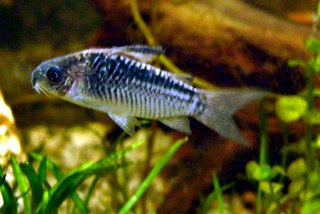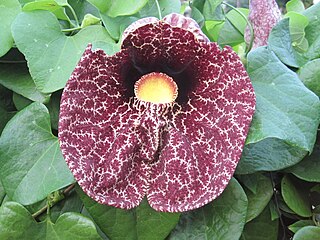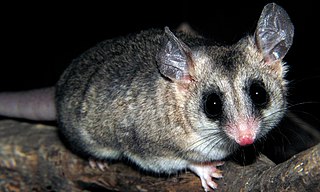Related Research Articles

Caenorhabditis elegans is a free-living transparent nematode about 1 mm in length that lives in temperate soil environments. It is the type species of its genus. The name is a blend of the Greek caeno- (recent), rhabditis (rod-like) and Latin elegans (elegant). In 1900, Maupas initially named it Rhabditides elegans. Osche placed it in the subgenus Caenorhabditis in 1952, and in 1955, Dougherty raised Caenorhabditis to the status of genus.

The chestnut woodpecker a species of bird in subfamily Picinae of the woodpecker family Picidae. It is found on Trinidad and in every mainland South American country except Argentina, Chile, Paraguay, and Uruguay.
Savia is a genus of the family Phyllanthaceae first described as a genus in 1806. It is native to the West Indies, the Florida Keys, Mexico, Venezuela, Brazil, and Paraguay.
- Savia dictyocarpaMüll.Arg. - Paraguay, S Brazil
- Savia sessiliflora(Sw.) Willd. - Mexico, West Indies, Venezuela

The elegant corydoras or elegant catfish is a tropical freshwater fish belonging to the subfamily Corydoradinae of the family Callichthyidae. It originates in inland waters in South America, and is found in the Upper Amazon River basin in Brazil, Colombia and Peru. The specific epithet elegans means elegant.

Aristolochia littoralis, the calico flower or مورپنکھ بیل or elegant Dutchman's pipe, is a species of evergreen vine belonging to the family Aristolochiaceae.

The Brazilian laniisoma, also known as the shrike-like laniisoma, the shrike-like cotinga or the elegant mourner, is a species of bird in the family Tityridae. As suggested by its common name, it was formerly considered a cotinga. As it is far from being "shrike-like", this means that the widely used common name is entirely misleading.

The elegant woodcreeper is a species of bird in the subfamily Dendrocolaptinae of the ovenbird family Furnariidae. It is found in Bolivia, Brazil, Colombia, Ecuador, and Peru.

The elegant fat-tailed mouse opossum, also known as the Chilean mouse opossum, is an opossum from central Chile. The type species of Thylamys, it was first described by English naturalist George Robert Waterhouse in 1839. This medium-sized opossum is characterized by black rings around the eyes, white limbs, gray to light brown coat, lighter flanks and underbelly and a thick 12.7–14.6 centimetres (5.0–5.7 in) long tail covered with hairs. It is crepuscular and lives in nests in tree hollows or under rocks and roots. This opossum feeds mainly on arthropods and larvae apart from fruits. Litter size is typically between 11 and 13. The elegant fat-tailed opossum can occur in a variety of habitats – from cloud forests to chaparrals. The IUCN classifies the opossum as least concern.
Pau Brasil National Park is a national park in the state of Bahia, Brazil. It preserves a remnant of the Atlantic Forest biome.

Cypella is a genus of herbaceous, perennial and bulbous plants in the family Iridaceae. It is distributed in South America, from Peru and Brazil to Northern Argentina. The genus name is likely derived from the Greek word kyphella, meaning "hollow of the ear", and alludes to the shape of the inner tepals.
Chaetosphaeria is a genus of fungi in the family Chaetosphaeriaceae.

Vriesea duvaliana is a plant species in the genus Vriesea. It is an epiphyte endemic to the State of Bahia in eastern Brazil, but cultivated in other regions as an ornamental. It is a recipient of the Royal Horticultural Society's Award of Garden Merit.

Platypodium elegans, the graceful platypodium, is a large leguminous tree found in the Neotropics that forms part of the forest canopy. It was first described by Julius Rudolph Theodor Vogel in 1837 and is the type species of the genus. The tree has been known to grow up to 30 metres in height and have a trunk with a diameter up to 1 m at breast height. Its trunk has large holes in it, sometimes making it possible to see through the trunk. The holes provide a habitat for giant damselflies and other insects both when alive and once the tree has died and fallen over. It has compound leaves each of which is made up of 10–20 leaflets. Three new chemical compounds have been isolated from the leaves and they form part of the diet of several monkeys and the squirrel Sciurus ingrami. In Panama it flowers from April to June, the flowers contain only four ovules, but normally only one of these reaches maturity forming a winged seed pod around 10 cm long and weighing 2 g. During the dry season around a year after the flowers are fertilised, the seeds are dispersed by the wind and the tree loses it leaves. The seeds are eaten by agoutis and by bruchid beetle larvae. The majority of seedlings are killed by damping off fungi in the first few months of growth, with seedlings that grow nearer the parent trees being more likely to die. The seedlings are relatively unable to survive in deep shade compared to other species in the same habitat. Various epiphytes are known to grow on P. elegans with the cactus Epiphyllum phyllanthus being the most abundant in Panama. Despite having holes in its trunk which should encourage debris and seeds to collect, hemiepiphytes are relatively uncommon, meaning that animals are not attracted to it to feed and then defecate. It has no known uses in traditional medicine and although it can be used for timber, the wood is of poor quality.

Cyriocosmus is a genus of tarantulas that was first described by Eugène Louis Simon in 1903. They are small to medium spiders, with a bicolored or one same color carapace.

Bothriospila is a genus of beetles in the family Cerambycidae, and the type genus of the tribe Bothriospilini. It contains two species: the type, Bothriospila elegans, found in Brazil and Paraguay, and Bothriospila pulcherrima, found in Brazil. The latter was described as a new species from Brazil in 2012. Bothriospila was circumscribed in 1923 by Swedish entomologist Per Olof Christopher Aurivillius.
Poeciloxestia elegans is a species of beetle in the family Cerambycidae. It is found in Brazil.
C. elegans most commonly refers to the model round worm Caenorhabditis elegans. It may also refer to any of the species below. They are listed, first in taxonomic order and, second, alphabetically.
Characiopsis elegans is a species of freshwater yellow-green algae in the family Characiopsidaceae. It is described from Arkansas, North America and Brazil, South America.

Bauruemys is an extinct genus of turtles in the family Podocnemididae.
Fridericia elegans is a species of plants in the family Bignoniaceae. It is found in Brazil, where it is poisonous to livestock and has caused severe losses.
References
- ↑ Brotéria: revista de sciencias naturaes do Collegio de S. Fiel (in Brazilian Portuguese). La Bécarre. 1905. p. 45.
- ↑ "Species Fungorum - Names Record". www.speciesfungorum.org. Retrieved 10 September 2023.